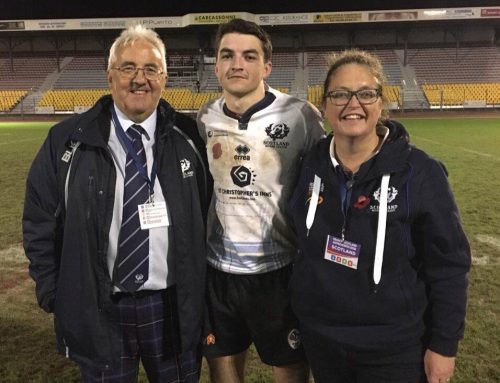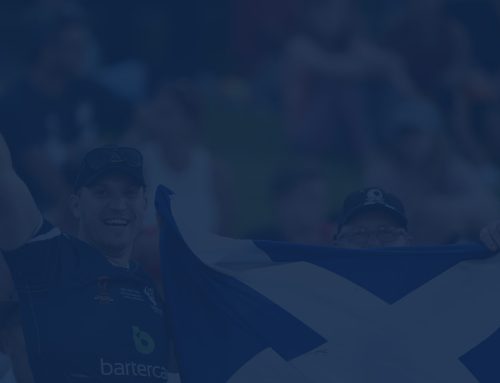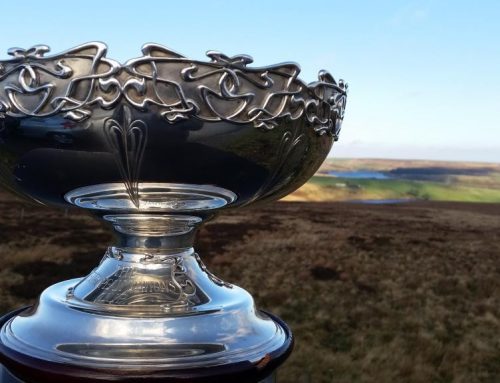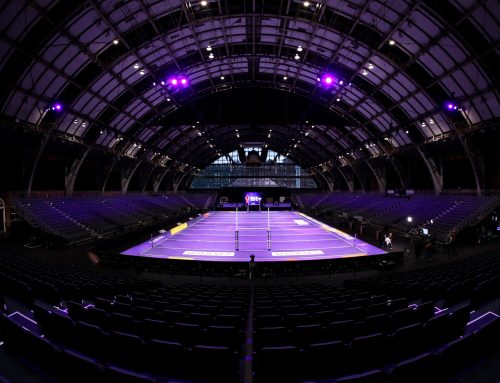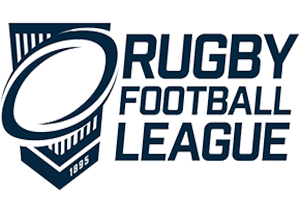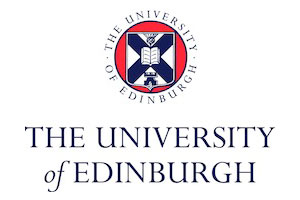“I went over under the posts and got hit really hard from the side, I was over the line and the ball popped out of my hands and went backwards, hit the posts and then I got it down. It’s a shame we didn’t have VAR back then, because I’m fairly sure it was a good try”.
Oh, what might have been. If Struan Douglas is to be believed, the first full men’s international for Scotland Rugby League, played 25 years ago yesterday, could well have been a victory.
The Stena Sealink Challenge vs Ireland, at the Royal Dublin Showgrounds on the 13th of August 1995 was a landmark occasion for Rugby League in Scotland. The team lost on the day, falling 26-22 despite tries from Sean Cusack, Darrall Shelford and Gavin Manclark (and perhaps a ghost try from Douglas). The result on the day wasn’t the be all and end all, however, with the legacy of the first match, as well as the stories that it generated being much more important to the players involved in the game.
Scotland’s first international match was a far cry from the slick organisation that one associates with modern internationals. Ali Blee noted that the Stena Sealink challenge was an apt name for the match, given the lengthy minibus, car, and ferry journeys that the team had to make to arrive in Dublin. Graeme Thompson and Struan Douglas managed to complete a mini tour of the UK, having to drive through Scotland, England, Wales and Northern Ireland to arrive at their mixed dorm youth hostel in Dublin.
It was an extremely busy weekend in Dublin. The Horse of the Year show, Manchester United vs Shelbourne Rovers, and the Rugby League Charity Shield Final between Wigan and Leeds (which immediately followed Scotland’s game, and included Scotland’s would-be captain Alan Tait). The team couldn’t even get changed at the stadium, so had to walk through the streets of Dublin in full kit, led by a piper, to arrive at the Showgrounds. Following the Horse of the Year show meant the pitch was patched with sand, and horse manure skirted the touch lines, something Ali Blee vividly remembered:
“As a winger the manure at the side of the pitch is something I remember markedly, it was like being back in Cumbria, running up and down hills dodging deep puddles!”.
It was hardly the most glamorous start to Scotland’s international career. Man of the Match, Graeme Thompson, was given a travel voucher as a reward for his efforts; although “Voucher” was a pretty loose term, as all he was handed was a business card with “£100” scribbled on the back. Graeme opted to give his match day prize to a friend, so we’ll never know whether the “voucher” worked in the end.
It would be a cliché to say that the match in Dublin was less about the destination, but more about the journey of Scotland Rugby League, but this isn’t lost on the players from the game. John Coumbe-Lilley, who sadly had to leave the field injured in the opening minutes of the match, commented that:
“As a team and a sport it felt like we were going in the right direction. It was a really exciting period to be part of Scotland Rugby League. It was great to see the enthusiasm and the passion that the team and people in the background had, and realise the fruits of everybody’s labour”.
Each player noted the passion of the team and the commitment of all their teammates. The squad was largely made from a core of Student players, with a few professional players added in. For Thompson it was about getting the right professionals and characters to fit in with the commitment levels of the rest of the team: “Darrall Shelford was the epitome of it, Charlie McAlister too. They all had to pay the same match fees as us.” The team brought together players born in Scotland as well as those who qualified through heritage, with students playing alongside seasoned professionals. While the players had different backgrounds, their commitment was the same, with a respect for one another and the country they were representing. The foundations of the team being a mixture of different backgrounds can be seen to this day, with the clear pathway from student team to senior team still evident. In 2019, Matt Hogg, still a university student, was playing and battling alongside Luke Douglas, who still holds the record for the most consecutive games started in the NRL.
Thompson recounted the following story, which nicely summed up the diverse make-up of the team:
“Alan Tait introduced himself to Stu McCarthy and said, ‘Hello there, I’m Alan Tait, Great Britain and Leeds’, and Stu, who was from Essex, just turned around and said, ‘Stu McCarthy, Canvey Island Second Team’”.
Thompson, Coumbe-Lilley, Douglas, and Blee could probably have chatted about their days playing for Scotland for hours. A common theme from their stories, and when asked about the legacy of the match against Ireland, was the people that they encountered. All four are immensely proud of seeing what the first team are doing today, with the driving force of the squad and the organisation being the characters and leaders that have been embedded within Scotland Rugby League since the team first started. Coumbe-Lilley shared a story which summed up the attitudes that have always been central to the team;
“Myself and Ali (Blee) actually had a scuffle at training, and Iain Stanger brought us together and made us shake hands. It’s all about people, Stanger was a leader, and being around people like that is the legacy also. I still go back to the people who I met through Scotland Rugby League, and I have a library of characters and people that I can draw on to this day.”
Written by James Parsons, Media Manager
To listen to the full podcast episode, click here




